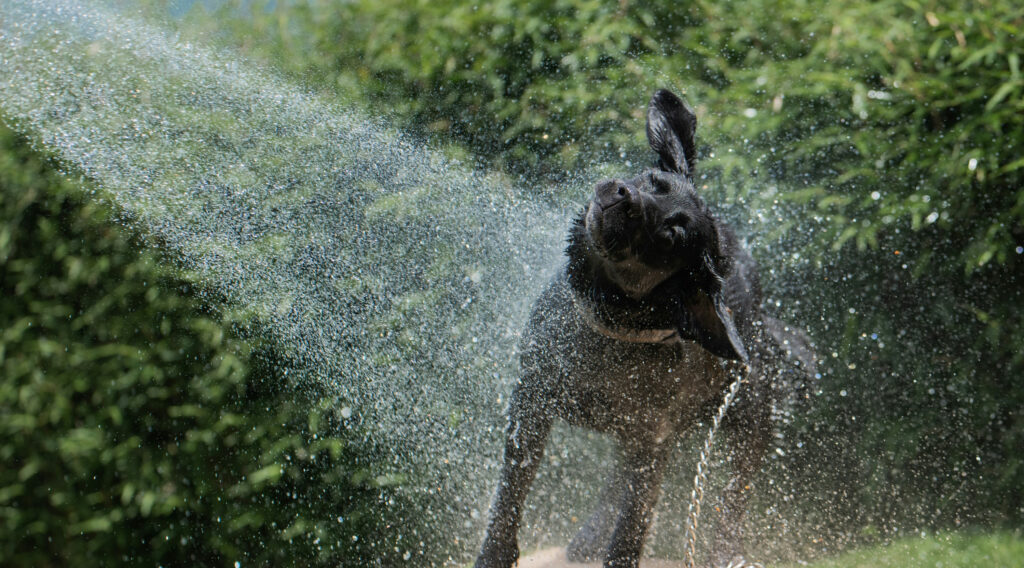My experience has taught me that some dogs are more vulnerable than others — senior dogs, overweight pups, and breeds with flat faces like bulldogs and pugs need extra attention when temperatures rise.
Summer should be fun for our dogs, but it requires us to think ahead and watch for warning signs. Here’s what I’ve learned about keeping dogs safe when the heat is on.
(⚠️ Disclaimer: These are general safety tips. Always consult your vet about your individual dog’s needs, especially if they have health conditions or are particularly heat-sensitive.)
Recognizing Heat Stress — The Critical Signs
Dogs can’t sweat through their skin like we do — they rely mainly on panting to cool down. I’ve learned to watch carefully for these warning signs:
- Excessive panting or drooling — more than normal exercise panting
- Rapid heartbeat — you can feel this by placing your hand on their chest
- Lethargy or unsteadiness — stumbling or seeming “off”
- Vomiting or diarrhea — especially if it comes on suddenly
If you see any of these signs, don’t wait. Move your dog to shade immediately, offer small amounts of cool water, and contact your vet. I’ve seen dogs go from seeming fine to being in serious trouble in just minutes.
Smart Walking Strategies
I’ve learned the hard way that the “hand test” for pavement is essential — if you can’t hold your hand comfortably on the asphalt for 5 seconds, it’s too hot for paw pads. I stick to early morning or evening walks during summer, and I always carry water.
Some of the rescue dogs I work with have never learned to communicate when they’re getting too hot, so it’s up to us to be their advocates and cut walks short when needed.
Hydration is Everything
Always carry a collapsible bowl and water bottle on walks — I learned this after watching a dog desperately try to drink from a puddle on a hot day. At home, I recommend multiple water bowls placed in shaded areas, and offering small amounts frequently rather than waiting for your dog to seek it out.
Some dogs, especially those from neglectful situations, don’t have good instincts about drinking enough water, so monitoring their intake becomes even more important.
Creating Cool Spaces
Shade is non-negotiable, but I’ve found that cooling mats or even damp towels can provide extra relief. Air conditioning is ideal when possible, but never rely on just a fan — dogs can still overheat even with airflow.
I’ve worked with families who set up cooling stations around their yard with different options, so their dog can choose what feels best.
The Car Rule — No Exceptions
I’ll be blunt: never leave your dog in a parked car during warm weather, even with windows cracked. I’ve responded to many emergency calls where well-meaning owners thought “just a few minutes” would be okay. Car temperatures can become lethal in minutes, not hours.
Grooming Considerations
Here’s something that surprises people: don’t automatically shave long-coated dogs. Their fur actually provides insulation against heat and protects from sunburn. A professional groomer can do a “summer trim” that helps without removing the protective qualities of their coat.
Safe Water Play Options
Most dogs love water play, but supervision is key. A kiddie pool with just a few inches of water, sprinkler time, or supervised swimming can provide great relief. Just remember to dry their ears afterward — trapped moisture can lead to infections.
I’ve worked with several dogs who were initially afraid of water due to past experiences, so go slow and let them set the pace.
Sun Protection for Vulnerable Dogs
Light-colored dogs, those with thin coats, or dogs with pink noses and ears can actually get sunburned. Your vet can recommend pet-safe sunscreen — never use human sunscreen containing zinc oxide, as it’s toxic to dogs.
Emergency Preparedness
Know your vet’s summer hours and keep an emergency clinic number saved in your phone. Heat-related emergencies can escalate quickly, and having a plan ahead of time can save precious minutes.
I always tell people: when in doubt, err on the side of caution. It’s better to call your vet unnecessarily than to wait too long when your dog is in distress.
Summer doesn’t have to be scary for our dogs, but it does require us to be thoughtful and prepared. Pay attention to your individual dog’s limits — they vary widely based on age, health, breed, and past experiences. Your dog is counting on you to keep them safe, and with a little planning, you can both enjoy the season together.

